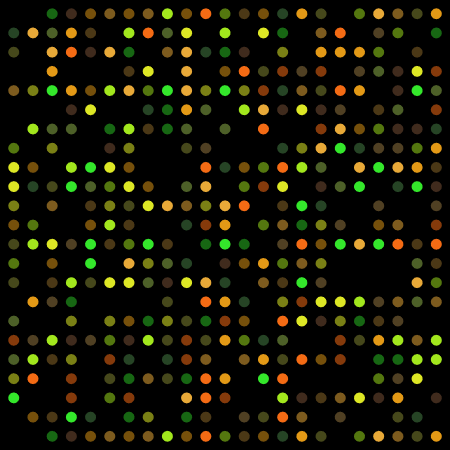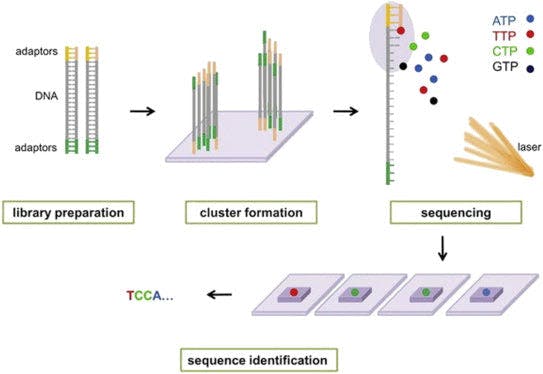Our world here at Basepaws revolves around your cat's DNA. In order to analyze feline genes, we must first decode the information within them. Many labs still rely on microarray techniques for genotyping studies due to a number of advantages. We, however, employ data-rich DNA sequencing in all aspects of our work.
Here we summarize the key differences between these two approaches for genotyping studies. Microarrays vs Next Generation Sequencing (NGS): which should you choose?
Microarrays
A DNA microarray is a collection of short DNA fragments attached to a solid surface. Microarrays can be used to measure the expression of many genes simultaneously and to genotype multiple regions of a genome. The core principle of the method is based on hybridization between two complementary DNA strands. When DNA fragments are attached to a surface, they can be exposed to fluorescently labeled target sequences.
These target sequences will bind to highly complementary sequences on the surface. The surface is then washed, and all fragments that didn't bind to the microarrays are washed away. The subsequent screening of the fluorescent signal identifies the sequences which were binded by the target fragments. Using DNA microarrays doesn't allow the identification of previously unknown sequences.
The microarray technique has been used for decades, and it certainly has a number of advantages. However, it is also:
1. Slow to respond to the latest discoveries in genetics – There are large costs and long timelines associated with re-designing the microarray chip to include newly discovered genetic targets, which optimally requires designing an initial screening array first, followed by a smaller array for routine use.
2. Difficult to design in the absence of pre-existing Next Generation Sequencing (NGS) data – The limited amount of publicly available cat genomic data makes selecting microarray candidate gene variants difficult. In addition, not all selected variants will work in a microarray assay, as there are limitations associated with the hybridization efficiency of the array.
3. Unsuitable for discovery – Microarrays have potential for Genome Wide Association Studies (GWAS), but since the genetic targets on a microarray are pre-selected, new gene variants cannot be discovered.

Microarrays vs Next Generation Sequencing: DNA microarray (source)
Next Generation Sequencing (NGS)
DNA sequencing is a technique which determines the order of nucleotides in a DNA sequence. As explained in the blog about Basepaws science, the DNA molecule consists of two polynucleotide chains. To determine the precise order of these nucleotides in the DNA molecule, we have to sequence it. Different methods or technologies can be used for this. The most basic methods for DNA sequencing are Maxam-Gilbert and Sanger. More advanced and faster methods are also available. These are Next Generation Sequencing (NGS) and Third Generation Sequencing.
Next Generation Sequencing (NGS), also known as high-throughput sequencing, is an umbrella term for a number of modern sequencing technologies. Basepaws employs the Illumina DNA sequencing platforms – the most broadly used NGS DNA sequencers across labs today. The Illumina NGS method is based on reversible dye-terminators that enable the identification of single bases as they are introduced into DNA strands. Illumina platforms sequence a wide range of fragments, ideally around 300-350 base pairs.
The reason we opt for DNA sequencing rather than microarrays for our genotyping studies is related to the following advantages of NGS:
1. No prior data required − We are not limited by the scarcity of publicly available feline genomic data.
2. High discovery potential – NGS allows discovery of previously unknown gene variants.
3. The method has much greater flexibility than microarrays, since there is no need for hardware redesign every time a new gene variant is to be studied.

Microarrays vs Next Generation Sequencing: An overview of Illumina sequencing From Zhou, X., Li, Y., 2015 (source)
Basepaws is dedicated to new discoveries within feline science and genetics. We want to learn more about cats and their health and ancestry. This is the purrfect place for the creation of novel and more efficient tools for genomic analysis. We have an active Research & Development team that is continuously optimizing our processes to increase efficiency and develop new technologies. After intense optimization of lab processes, we have found that DNA sequencing works best for all the analyses conducted in our labs and it allows us to drive feline research forward faster than microarray technology would.
